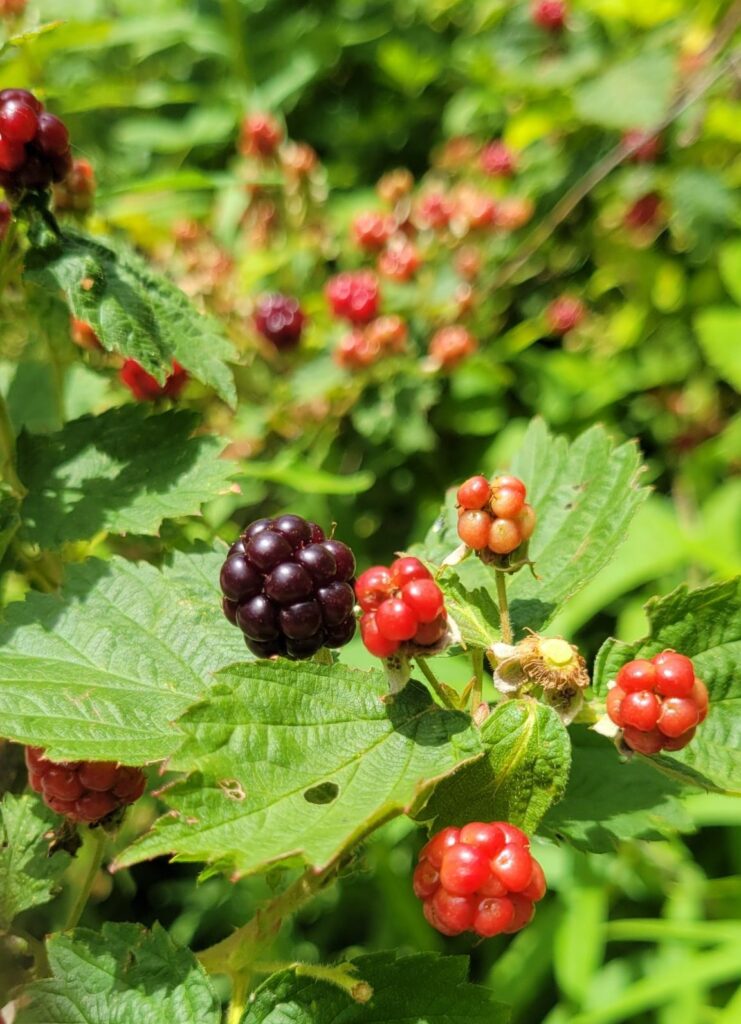There are few things more nostalgic to me than berry picking. Walking the lane behind my house with my mother, plucking the ripened purple berries while carefully avoiding thorns.
Placing all we gathered carefully into a tupperware container, save for two or three for a seedy trail snack. Wild edibles and foraging are always popular topics and what better time to learn more about the subject than right now! Move over fall, because summer offers a whole bounty of harvestable forage for both people and animals alike, mainly, berries.
Walking along a sunny path this time of year, you are likely to notice dark purple berries dotting the trail. Some of the most common summer foragable berries are actually two species, the Black Raspberry (Rubus occidentalis) and the Allegheny Blackberry (Rubus allegheniensis). Though both are edible, tasty, and very similar at first glance, there are a few surefire ways to know which berries you are looking at.
Black raspberries are generally ripe for the Fourth of July, making for a great addition to barbeques. The stems of the black raspberry also have a dusty white substance that coats it, similar in appearance to talcum powder. This characteristic in botany is called being “glaucous” (bless you), and the powder can be wiped off with your finger.
Alternatively, blackberries begin to come into season towards the end of the black raspberries. Though there is a fair bit of overlap initially, blackberries will generally have a later season than its counterpart. Additionally, blackberries are not glaucous, making the stem a greenish-brown color with no powdery substance. Stems of this plant are also heavily angled in a way that makes it look like a star under a cross section. There is slight taste variation in these fruits; the black raspberry is a bit sweeter than the blackberry. Maybe a touch more sugar will be needed in cooking with the blackberry.
Elderberry (Sambucus nigra) is another common summer berry. This plant hosts small white flowers throughout June and July, which precedes tiny, dark colored, singular fruit that you can find from August through October. The elderberry is often harvested for its long list of supposed medical benefits, ranging from treatments for colds, to lowering the risk of heart disease. In more everyday applications, the elderberry fruit can be jellied, pied, or eaten fresh.
Before going out and finding your own trail to harvest from, it is important to positively identify these plants. While generally safe, summer forage has fruits that were never meant for mammalian consumption, like poison ivy, pokeberry, Virginia creeper, and white baneberry. These all produce fruit toxic to humans, but a delight for birds!
This raises a vital point in summer foraging: don’t over-harvest! Through all the whimsy of gathering from nature, it is important to remember that wildlife of all varieties rely on forage to sustain themselves. With that in mind, be respectful to nature and be sure to leave plenty of food for the plethora of critters that need it. Because Red-tail Land Conservancy’s nature preserves are home to diverse wildlife, visitors are asked not to gather berries.
I think many share some version of my berry-picking story. A story that deepens your connection to nature beyond what you observe, but more so, what you feel. Pie was my mother’s ultimate goal when I was younger. Turning the fruits of our labor into something sweet to share with our family. I can still taste the warm crust, softening from the melted scoop of vanilla ice cream placed on top. These memories are forever tangled with nature, like the twisting raspberry branches themselves. You too can create lifelong connections to the natural world that surrounds you.
Jake Gamble is the Stewardship Coordinator for Red-tail Land Conservancy. Impassioned by land conservation, he strives to protect and preserve the natural quality of Indiana while inspiring others to do the same.
Pictured above: black raspberry




